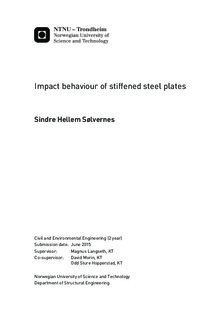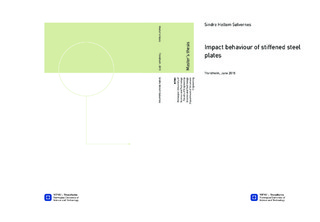| dc.description.abstract | The impact behavior of stiffened steel plates subjected to impact loading from concentrated loads was studied experimentally and numerically. Both dynamic and quasi-static tests of stiffened steel plates with geometry adopted from a typical external deck area on an offshore platform were conducted. The quasi-static tests were performed to study the relationship between dynamic impact behavior and the corresponding static ones. All tests were carried out in scale 1:4.
To allow the execution of generic testing in the laboratory, a steel frame that defines the support conditions for the test components is designed and constructed. Prior to the execution of the experimental programme, numerical models were created and several preliminary simulations of the tests were performed. The results from the preliminary simulations were directly used in the design phase of the tests, i.e. design of the test components and the support frame, determination of appropriate contact area between load and component, and determination of the load magnitude.
Tension tests were carried out to provide the necessary information on the strength and ductility of the steel material used in the stiffened plates. Based on the information obtained from the material tension tests, material models were created and implemented into the numerical models of the dynamic and quasi-static tests.
Comparisons between the numerical and experimental results were performed, mainly by comparing force-displacement curves. In order to determine the capacity of the stiffened steel plates by numerical simulations, three main approaches that involve predicting tensile failure was implemented.
The first approach is to use the Cockcroft-Latham fracture criterion which is based on calculation of accumulated damage during straining. With this approach it was possible to calculate the capacity with high precision. However, the way this fracture criterion was implemented it was inefficient with regard to computational time as it required a very dense mesh to obtain reliable results.
In the second approach, the Bressan-Williams-Hill instability criterion which is based on predicting the onset of local necking in a sheet metal was implemented. This method can be used with success for large-scale shell structures, where the element length is considerable larger than the plate thickness. For the applicable structure in this report, the Bressan-Williams-Hill instability criterion predicted acceptable estimates of the capacity, although with a higher degree of conservatism than expected in advance.
In the final approach a simplified check against tensile failure was performed according to a recommended practice from DNV-GL. The simplified approach provided conservative values of the plate capacity compared to the tests. | |

